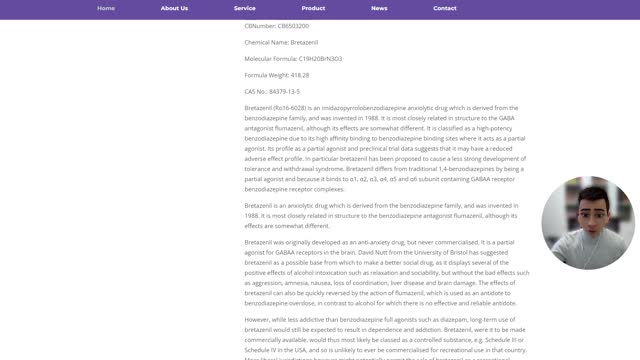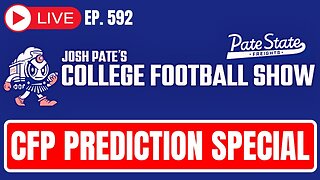Premium Only Content

cas: 84379-13-5 Bretazenil factory low price
cas: 84379-13-5 Bretazenil factory low price
CBNumber: CB6503200
Chemical Name: Bretazenil
Molecular Formula: C19H20BrN3O3
Formula Weight: 418.28
CAS No.: 84379-13-5
Bretazenil (Ro16-6028) is an imidazopyrrolobenzodiazepine anxiolytic drug which is derived from the benzodiazepine family, and was invented in 1988. It is most closely related in structure to the GABA antagonist flumazenil, although its effects are somewhat different. It is classified as a high-potency benzodiazepine due to its high affinity binding to benzodiazepine binding sites where it acts as a partial agonist. Its profile as a partial agonist and preclinical trial data suggests that it may have a reduced adverse effect profile. In particular bretazenil has been proposed to cause a less strong development of tolerance and withdrawal syndrome. Bretazenil differs from traditional 1,4-benzodiazepines by being a partial agonist and because it binds to α1, α2, α3, α4, α5 and α6 subunit containing GABAA receptor benzodiazepine receptor complexes.
Bretazenil is an anxiolytic drug which is derived from the benzodiazepine family, and was invented in 1988. It is most closely related in structure to the benzodiazepine antagonist flumazenil, although its effects are somewhat different.
Bretazenil was originally developed as an anti-anxiety drug, but never commercialised. It is a partial agonist for GABAA receptors in the brain. David Nutt from the University of Bristol has suggested bretazenil as a possible base from which to make a better social drug, as it displays several of the positive effects of alcohol intoxication such as relaxation and sociability, but without the bad effects such as aggression, amnesia, nausea, loss of coordination, liver disease and brain damage. The effects of bretazenil can also be quickly reversed by the action of flumazenil, which is used as an antidote to benzodiazepine overdose, in contrast to alcohol for which there is no effective and reliable antidote.
However, while less addictive than benzodiazepine full agonists such as diazepam, long-term use of bretazenil would still be expected to result in dependence and addiction. Bretazenil, were it to be made commercially available, would thus most likely be classed as a controlled substance, e.g. Schedule III or Schedule IV in the USA, and so is unlikely to ever be commercialised for recreational use in that country. More liberal jurisdictions however might potentially permit the sale of bretazenil as a recreational alternative to alcohol, especially in countries such as Russia where liver and brain damage from chronic alcohol abuse place a severe burden on the health service and so the potential advantages of a less toxic alternative drug might outweigh the complications of introducing a new recreational drug to the market
The imidazobenzodiazepines bretazenil, imidazenil, and FG-8205 (Figure 10a) are high-affinity partial agonists for GABAA receptor subtypes that contain α1, α2, α3, and α5 subunits. These compounds are anxiolytic in animal models, with a greater separation between doses required for anxiolytic versus sedative effects than that observed for diazepam. Where studied, these compounds also show little evidence for tolerance to the anxiolytic effects, do not display withdrawal, and have a lower abuse potential than full BZ agonists in nonhuman primates. Bretazenil (Figure 10a) entered clinical studies in the mid-1980s and was efficacious in GAD and panic disorder,112 with a lower abuse potential than diazepam.113 However, bretazenil was sedative, with little evidence for separation between anxiolytic and sedative effects,114 and its clinical development was discontinued.
-
 2:44
2:44
Memology 101
9 hours ago $3.24 earnedWhat a snake...
11.3K6 -
![🔴LIVE : THE FINALS Season5 [The World's STRONGEST Gamer] 1080p 60fps](https://1a-1791.com/video/s8/1/4/m/-/L/4m-Lv.0kob-small-LIVE-THE-FINALS-Season5-The.jpg) 2:14:36
2:14:36
PacPowerTV
8 hours ago🔴LIVE : THE FINALS Season5 [The World's STRONGEST Gamer] 1080p 60fps
70.3K9 -
 5:11:27
5:11:27
Joe Donuts Gaming
8 hours ago🟢Live : City Boy Inherits A Ranch 😧😓
48.7K5 -
 3:41:12
3:41:12
Fresh and Fit
14 hours agoDaniel Penny ACQUITTED & BLM Meltdown
109K29 -
 42:46
42:46
barstoolsports
12 hours agoThe Shred Line with Coach Gruden, Dave Portnoy and Steven Cheah | Week 15
74.4K5 -
 3:43:53
3:43:53
EricJohnPizzaArtist
8 hours agoAwesome Sauce PIZZA ART LIVE Ep. #27: Christmas Special! Dr. Disrespect is Coming to Town!
43.1K9 -
 1:42:14
1:42:14
TheDozenPodcast
15 hours agoConor McGregor, Raoul Moat, Burglary, BKFC Heavyweight Champion: Mick Terrill
72.4K3 -
 2:10:02
2:10:02
vivafrei
18 hours agoEp. 241: Stephanopoulos PAYS for Defamation! Accused CEO Shooter Gets ELITE Attorney! Drone Madness
189K124 -
 6:05:13
6:05:13
Right Side Broadcasting Network
6 days agoLIVE REPLAY: NYYRC 112th Annual Gala Ft. Steve Bannon, Nigel Farage, and Dan Scavino - 12/15/24
237K16 -
 1:22:45
1:22:45
Josh Pate's College Football Show
12 hours ago $5.12 earnedCFP First Round Predictions | Travis Hunter Heisman | Transfer Portal Intel | Biggest Misses In 2024
47.6K